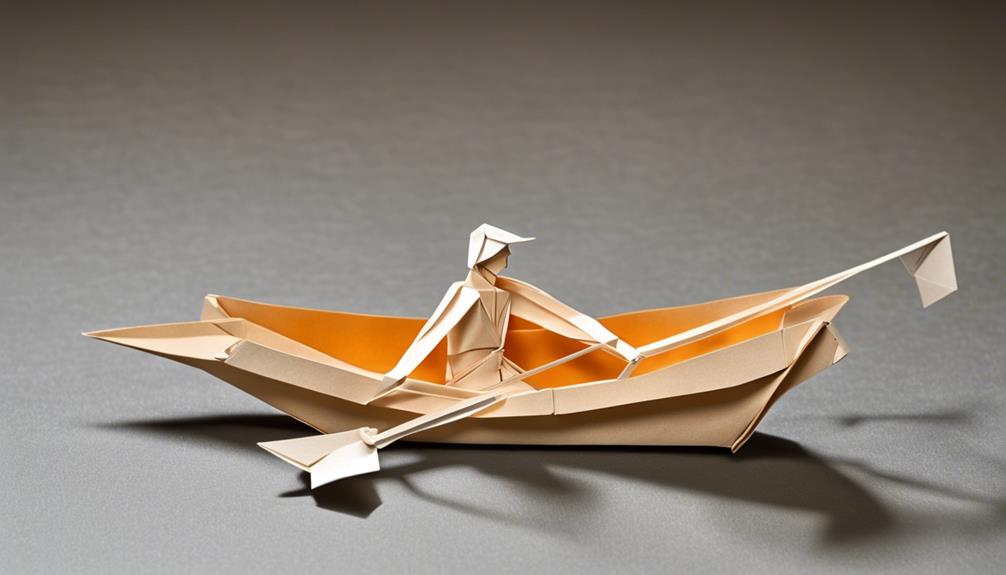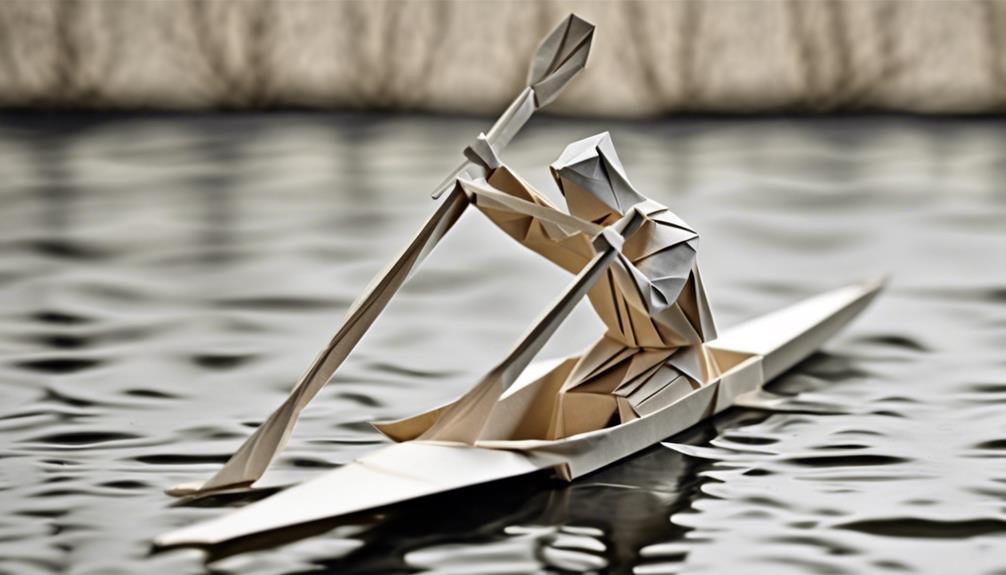General Rules of Sculling Rowing
If you're stepping into the serene world of sculling rowing, mastering the General Rules is paramount. From ensuring your equipment is top-notch to navigating boating traffic with finesse, these guidelines set the tone for a smooth rowing experience. But there's more to it than just the basics. Are you ready to uncover the nuanced safety precautions and essential racing rules that will elevate your sculling game? Stay tuned for a comprehensive insight into the intricate world of sculling rowing.
Equipment Requirements

When preparing for sculling rowing, ensure you have the necessary equipment to enjoy a safe and successful experience on the water. Equipment maintenance and repair are crucial aspects of owning sculling gear. Regularly inspect your oars for any signs of wear and tear, such as cracks or splinters, and promptly address any issues to prevent accidents while rowing. Ensuring that your equipment is in top condition not only enhances your performance but also keeps you safe during your water adventures.
Proper storage and transport of your sculling equipment are equally important. After each use, rinse off your oars and boat to remove any salt or debris that could cause damage over time. Store your gear in a cool, dry place to prevent warping or degradation. When transporting your sculling equipment, secure it properly to avoid any damage during transit. Use protective padding to prevent scratches or dents, especially when loading and unloading your gear.
Boating Traffic Rules
As you navigate the waters while sculling, it's crucial to understand the Waterway Right of Way rules, be aware of Navigation Signals, and always prioritize Safety Precautions. These points will guide you in determining who has the right of way, how to communicate with other boaters, and most importantly, how to stay safe on the water. By following these guidelines, you can ensure a smooth and secure rowing experience.
Waterway Right of Way
Navigating waterways can be a complex task, with specific rules governing the right of way for boats and ensuring safe boating traffic flow. Boat etiquette is crucial for harmonious waterway usage. When approaching a river crossing, yield to boats already in the channel. Waterway etiquette dictates that slower vessels should keep to the right to allow faster boats to pass safely. Understanding passing techniques is essential to prevent accidents. When overtaking another boat, maintain a safe distance and alert them of your presence. Always pass on the port side, and once clear, return to your original course. Following these guidelines ensures a smooth and safe passage for all waterway users, promoting a respectful and enjoyable boating experience.
Navigation Signals
Understanding navigation signals is essential for safe boating and efficient traffic management on waterways. Signal etiquette and communication protocols play a crucial role in ensuring smooth sailing experiences. Navigational aids, such as buoys and lights, help convey important information to other boaters about your direction and intentions. It's vital to familiarize yourself with these signaling techniques to avoid collisions and navigate waters confidently. Remember to use consistent signals to indicate turns, stops, and overtaking maneuvers, following the established maritime rules. By adhering to proper signaling practices, you contribute to a harmonious waterway environment where all participants can enjoy their time on the water safely. So, embrace these navigation signals as your allies in the vast expanse of water traffic.
Safety Precautions
To ensure a safe and enjoyable boating experience, familiarize yourself with the essential safety precautions and boating traffic rules. When out on the water, always have a well-equipped first aid kit on board in case of emergencies. It's crucial to know the emergency response procedures and have a plan in place. Keep a constant lookout for other boats and adhere to the designated traffic rules to avoid collisions. Be prepared to respond quickly and effectively in case of any unforeseen circumstances. Knowing how to navigate safely through busy waterways can prevent accidents and ensure a smooth rowing experience. By prioritizing safety and being aware of your surroundings, you can make the most of your time on the water.
Safety Precautions
When sculling in rowing, prioritizing safety is essential to ensure a successful and enjoyable experience on the water. Safety precautions play a crucial role in preventing accidents and ensuring that you can navigate the waterways with confidence. To start, always be prepared with an emergency response plan. Familiarize yourself with the proper procedures to follow in case of an emergency, such as capsizing or encountering severe weather conditions. Understanding how to react swiftly and effectively can make all the difference in ensuring your safety and the safety of your crew.
Injury prevention is another vital aspect of safety when sculling. Before heading out onto the water, take the time to warm up your muscles and stretch to prevent strains and injuries. Additionally, make sure your equipment is in good condition and that you are using it correctly. Proper technique is not only essential for performance but also for preventing unnecessary strain on your body. It's also crucial to stay hydrated and protect yourself from the elements by wearing appropriate clothing and sunscreen.
Launching and Landing Procedures

Before you head out onto the water, it's crucial to focus on safety during launching and docking procedures. Make sure to master the proper techniques for approaching and leaving the dock to prevent accidents. Additionally, always conduct thorough equipment checks before setting off to ensure a smooth rowing experience.
Safety During Launching
Ensuring a smooth and safe launch requires careful adherence to specific procedures and protocols. When it comes to launching etiquette, always follow the designated order to avoid collisions. Safety precautions are paramount; check that all rowers have life jackets on and know how to use them. Proper attire is crucial for safety; wear snug-fitting clothing to prevent entanglement with equipment. Double-check equipment requirements – oars, coxswain's kit, and boat integrity should all be inspected before launching. Emphasize communication; ensure everyone knows their roles and responsibilities during the launch process. By prioritizing safety, following proper etiquette, and wearing the right gear, you can launch your sculling boat efficiently and securely.
Docking Techniques
To successfully navigate docking techniques in sculling rowing, prioritize clear communication and precise coordination among team members. Docking challenges can arise due to varying water currents and wind conditions. Here are some tips to enhance your docking experience:
- Establish Clear Signals: Use hand gestures or verbal cues to communicate effectively during the docking process.
- Assign Roles: Designate specific tasks to each team member to ensure smooth teamwork coordination.
- Practice Precision Docking: Aim for accuracy when approaching the dock to avoid collisions or drifting.
- Anticipate Challenges: Be proactive in identifying potential obstacles and have contingency plans in place for a seamless landing.
Equipment Checks Before
Ensure that all necessary equipment undergoes thorough checks before launching and landing to maintain safety and efficiency during sculling rowing activities. When preparing for your rowing session, remember to wear proper clothing that allows for freedom of movement and protects you from the elements. Additionally, it is crucial to inspect all safety equipment before heading out onto the water. Below is a table outlining key items to check before launching and landing:
| Equipment | Checks Needed |
|---|---|
| Boat | Secure all rigging and check for damage |
| Oars | Check for proper adjustment and any cracks |
| Personal Flotation Device | Ensure it fits correctly and is in good condition |
Rowing Technique Basics

When perfecting your rowing technique, focusing on proper form and rhythm is key to maximizing efficiency and power output. To enhance your sculling skills, here are four essential aspects to consider:
- Body Positioning: Maintaining the correct posture throughout the stroke cycle is crucial. Sit tall with a straight back, engaging your core muscles to provide stability and power.
- Stroke Timing: Timing is everything in rowing. Coordinate your movements with your partner to ensure a smooth and efficient stroke sequence. The synchronization of your strokes will optimize the boat's speed.
- Power Application: The way you apply power to each stroke greatly impacts your performance. Push through your legs first, engage your back and arms, and finish with a strong pull to maximize the propulsion of the boat.
- Blade Placement: Pay attention to how you place the blades in the water. The entry angle and depth of the blade affect the boat's speed and stability. Aim for a clean entry and a quick release to minimize resistance.
Steering Techniques
For effective steering in sculling rowing, mastering the use of foot steering and rudder manipulation is essential for maintaining course direction and control. Steering accuracy and technique play a crucial role in ensuring smooth navigation on the water. Here are some key points to consider for enhancing your boat control and precision:
| Steering Technique | Description |
|---|---|
| Foot Steering | Utilizing your feet to steer the boat by applying pressure to the foot stretchers on either side. This method allows for quick adjustments while rowing. |
| Rudder Manipulation | Adjusting the rudder using the steering cables to navigate the boat in the desired direction. It requires coordination with your rowing strokes for effective control. |
Mastering these steering techniques will help you maintain a straight course, navigate sharp turns, and dock smoothly. Practice is essential to improve your steering accuracy and ensure you can handle various water conditions effectively. Remember, proper steering not only keeps you on course but also prevents collisions and enhances your overall rowing experience. Stay focused, keep practicing, and soon you'll have the confidence to steer your sculling boat with precision.
Oar Handling Guidelines

Properly handling your oars is crucial for maximizing your efficiency and power in sculling rowing. To ensure you're getting the most out of your strokes, consider the following guidelines:
- Oar Storage and Maintenance:
- Store your oars in a secure, dry place to prevent warping or damage.
- Regularly inspect your oars for any signs of wear and tear, and promptly address any issues to maintain optimal performance.
- Proper Grip:
- When gripping the oar, make sure your hands are spaced shoulder-width apart for better control and power.
- Avoid gripping the oar too tightly, as this can lead to fatigue and blisters. Find a balance that allows for a firm grip without unnecessary tension.
- Feathering Techniques:
- Practice feathering the oar correctly by rolling your wrists at the end of the stroke to minimize wind resistance.
- Focus on a smooth transition between the drive and recovery phases, maintaining a consistent blade height above the water.
Weather Conditions Considerations
Hey there, rower! When hitting the water for sculling, always keep an eye on the wind speed – it can seriously impact your performance. Remember, temperature plays a crucial role too, affecting both your body's response and the water conditions you'll encounter. Be sure to monitor the water conditions closely to ensure a safe and efficient rowing session.
Wind Speed Impact
When sculling in varying wind speeds, adjusting your technique becomes crucial to maintain control and efficiency on the water. The effect of wind speed on rowing cannot be underestimated, so mastering proper wind management techniques is essential. Here are four key points to consider:
- Stay Balanced: Keep your body centered and your oars level to counteract the wind's force.
- Adjust Stroke Rate: Increase your stroke rate to power through headwinds and decrease it to avoid rushing in tailwinds.
- Use Wind Angles: Angle your boat slightly into headwinds and away from tailwinds to maintain a straight course.
- Stay Flexible: Be ready to adapt your technique quickly based on the changing wind conditions.
Temperature Effects
Navigating the temperature effects while sculling rowing requires an understanding of how weather conditions can impact your performance on the water. When facing varying temperatures, your clothing choices play a crucial role in maintaining comfort and performance. Performance metrics can be affected by extreme hot or cold conditions, so it's vital to adjust your rowing technique accordingly. Hydration needs also shift with temperature changes, emphasizing the importance of staying adequately hydrated before and during your rowing session. Additionally, implementing proper recovery strategies post-row, such as stretching and refueling, becomes more critical in extreme temperatures to prevent fatigue and ensure optimal performance. Consider the table below for more insights:
| Temperature Effects Table |
|---|
| Clothing Choices |
| Performance Metrics |
| Hydration Needs |
| Recovery Strategies |
Water Conditions Monitoring
Monitoring water conditions while sculling rowing is essential for ensuring safety and optimizing performance on the water. When out on the water, remember these key points:
- Water quality monitoring: Regularly check water quality reports in your area to ensure safe rowing conditions.
- Safety protocols: Familiarize yourself with safety procedures and protocols to handle any unexpected situations effectively.
- Environmental impacts: Be mindful of the environment and how your rowing activities may affect it, making conscious decisions to minimize harm.
- Emergency response planning: Always have a plan in place for emergencies, including knowing how to call for help and having necessary safety equipment on board.
Racing Rules Overview
To excel in sculling rowing races, understanding the specific rules and regulations is paramount for a successful and fair competition experience. When it comes to racing, being well-versed in the rules can give you an edge over your competitors. Here's a brief overview of some key racing rules to keep in mind:
| Rule | Description |
|---|---|
| Lane Assignments | Lanes are typically assigned based on seeding times to ensure fair racing. |
| Steering Regulations | Proper navigation is crucial to avoid collisions and stay on the right course. |
| Passing Regulations | Overtaking other boats must be done safely and without impeding their progress. |
| Finish Line Etiquette | Knowing how to cross the finish line correctly can impact your final time. |
Understanding these rules can help you navigate the racecourse effectively and perform at your best. Remember, a solid grasp of the regulations combined with your race strategies and mental preparation can lead to success on race day. Training techniques and performance enhancement will only take you so far; it's the application of these strategies within the framework of the rules that will set you apart from the competition. Stay focused, stay informed, and above all, enjoy the thrill of competitive sculling racing.
Maintenance and Care Tips

For optimal performance and longevity of your sculling rowing equipment, regular maintenance and attentive care are crucial. To ensure your gear stays in top condition, here are some essential maintenance and care tips:
- Cleaning Techniques: After each rowing session, make sure to wash your sculling equipment thoroughly with fresh water. Use a mild soap and a soft cloth to remove any dirt, salt, or debris that may have accumulated during your time on the water. Pay special attention to the oarlocks and tracks, as they tend to collect grime easily.
- Storage Solutions: When not in use, store your sculling gear in a dry and well-ventilated area. Avoid direct sunlight exposure, as it can cause damage to the materials over time. Consider investing in a rack or wall mount to keep your equipment off the ground and organized.
- Repair Methods: Regularly inspect your sculling equipment for any signs of wear and tear. Address any issues promptly to prevent further damage. If you notice loose bolts, frayed cables, or damaged parts, seek professional repair services to ensure your safety on the water.
- Maintenance Schedule: Create a maintenance routine that includes regular checks, cleanings, and minor repairs. By staying proactive and consistent with your upkeep, you can extend the life of your sculling rowing equipment and enjoy optimal performance during your workouts.
Frequently Asked Questions
What Are Some Common Mistakes Beginners Make When Sculling?
When sculling, beginners commonly make mistakes like gripping the oar too tightly. Loosen your grip, focus on proper technique. Refine your form by watching video analyses. Stay patient, embrace corrections, and your skills will soar!
How Can Rowers Improve Their Endurance and Stamina for Sculling?
To enhance your endurance and stamina in sculling, focus on building endurance through consistent training. Engage in stamina-building exercises, maintain mental focus, and practice proper breathing techniques. Embrace challenges to push your limits.
Are There Any Specific Drills or Exercises That Can Help Improve Sculling Technique?
To improve your sculling technique, try sculling drills to refine your movements and technique exercises for better body positioning. Enhance your grip strength for control and stability, leading to smoother strokes.
What Is the Best Way to Prevent Blisters and Calluses While Sculling?
To prevent blisters and calluses while sculling, focus on proper grip technique. Ensure your equipment is well-maintained to reduce friction. Embrace techniques that prioritize comfort and protection, and you'll glide smoothly without worrying about painful hands.
How Can Rowers Adjust Their Sculling Technique for Different Water Conditions, Such as Choppy Water or Strong Currents?
In adapting techniques for changing conditions like choppy water or strong currents, focus on maintaining balance and power. Adjust your blade entry angle and stroke length accordingly. Stay flexible in your approach to handle the challenges effectively.






